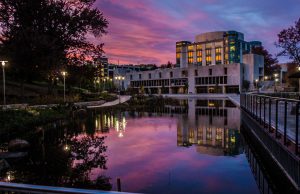
UMBC is advancing sustainability initiatives to conserve and preserve one of our most precious resources: water. UMBC prioritizes clean, healthy water and water conservation. Through operational practices, the university is consistently improving efforts in water conservation, effective stormwater management, and protection of the regional watershed. You can explore your local water quality using the EPA’s How’s My Waterway Tool. All these initiatives are integral in maintaining finite global water supplies, improving the health of ecosystems, and maintaining a sustainable future for our campus and region.
Learn More About Water @ UMBC
Local Drinking Water
Globally, more than a billion people are without access to safe, clean drinking water. Each year, an estimated three million people worldwide die from preventable waterborne diseases. However, in Baltimore, we can drink from virtually any tap with the highest level of confidence. UMBC is supplied with clean, fresh, drinking water from the City of Baltimore’s Department of Public Works (DPW). Baltimore City DPW has won recent awards for the quality and taste of its drinking water. Additionally, DPW’s water undergoes 150,000 water quality tests per year and consistently exceeds the EPA’s minimum standards for drinking water.
To ensure our tap water is safe for everyone to drink, the U.S. Environmental Protection Agency (EPA) requires water utilities to routinely test the drinking water for certain contaminants like bacteria, pesticides and heavy metals. Our water is continuously tested and monitored to ensure EPA standards are met. At UMBC our tap water comes from Baltimore City’s Department of Public Works (DPW) where the water undergoes 150,000 water quality tests per year and consistently exceeds the EPA’s minimum standards for drinking water. Whereas, purchased bottled water is regulated by the Food and Drug Administration (FDA) rather than the EPA.
Tap water plays an important role in our everyday lives. Clean tap water promotes public health, supports a growing economy, and improves the overall quality of life. A 20 oz. bottle of water costs, on average, $1.45, and generates plastic waste. But, when you use a 20 oz. reusable bottle and fill up at the tap (or a water fountain) that same $1.45 equates to over 1,000 refills!
The Container Recycling Institute estimates that 22 billion disposable water bottles end up in landfills each year. Since plastics aren’t biodegradable, the bottles stick around for hundreds of years. Not only that, but only about 1/4 of the plastic bottles used by Americans are recycled. Many of these bottles that are not recycled end up polluting the environment and posing a risk to wildlife.
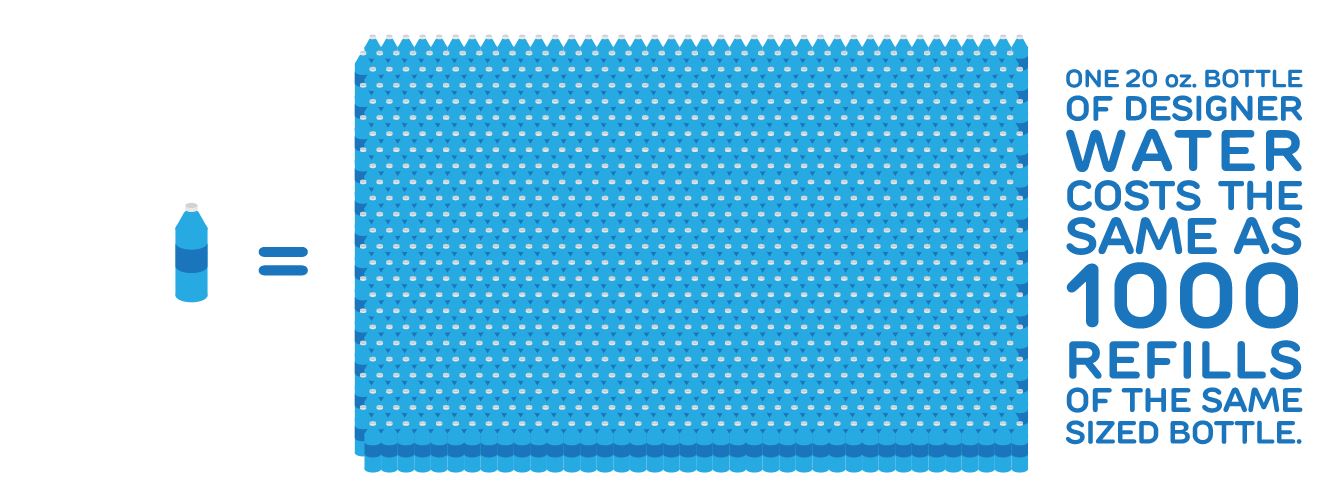
Campus Water Conservation
UMBC is committed to sustainable construction and renovation. All new buildings will have a minimum of a LEED Silver certification (or equivalent). LEED provides a framework to create healthy, highly efficient, and cost-saving green buildings. LEED certification is a globally recognized symbol of sustainability achievement. LEED employs a holistic approach to green building design incorporating sustainable sites and water efficiency. UMBC is continuously working to identify and implement opportunities throughout the campus, from innovative technologies to behavior change strategies to further increase our water conservation.
UMBC is consistently working to increase conservation efforts related to our resources. When it comes to conserving water, UMBC uses the following strategies:
- low flow plumbing fixtures
- smart, programmable, irrigation controls
- moisture sensors coupled with the irrigation controls
- A rainwater cistern to collect and reuse rainwater
Thanks to various water efficiency measures, the physical footprint of the campus has grown while the water footprint has decreased!
Stormwater
Only 3% of the Earth’s water can be used as drinking water. UMBC’s stormwater management program helps to protect Maryland’s water resources while allowing UMBC to minimize the impacts to the Chesapeake Bay Watershed. A recently completed hydrologic study provides UMBC with a holistic strategy for managing rainfall run-off originating from campus as well as from upland sources in Catonsville. Best management practices and site improvements that maximize environmental benefit and can be effectively integrated into future campus development were recommended. The study includes specific projects that have the potential to drastically improve how UMBC manages stormwater.
UMBC recognizes the importance of a holistic approach to campus development and sustainability will reinforce the existing natural systems of the campus including our approach to the treatment of stormwater management. The approach is to protect, enhance, and create functional landscapes that demonstrate and celebrate the way water serves as a resource. These landscapes also provide important habitat, microclimate, and aesthetic benefits that will be consistent with their specific locations on campus. Through a combination of forest preservation, stream rehabilitation, landscape conversions, and progressive water management solutions, like the creation of wetlands, the campus moves closer to a level of ecological balance. Each redevelopment and new development of quadrangles, courtyards, plazas, and walkways will target opportunities to incorporate working landscapes that enhance ecology and water management. Proposed ecological transformations to improve campus stormwater management and open space include:
- Extension of an existing stream bed into a new 10-acre wetland, enhancing stormwater treatment, habitat, and ecological function of the south of the campus within an existing low-lying stream buffer
- Improvements to the Central Green to improve the integration of stormwater management into existing outdoor spaces to control erosion, improve drainage, and enhance functionality
- Transformation of existing mowed grass areas, especially on steep slopes, into working native landscapes, to support pollinators and improve local water quality
- Growth of forest conservation areas that will preserve existing wooded areas and protect our stream valleys
What is stormwater?
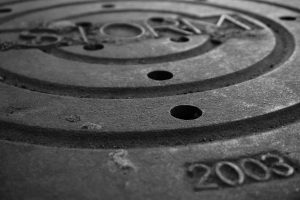 The Baltimore area, on average, receives 42 inches of precipitation per year. When it rains, or snow melts, where does it all go? In natural areas, the fallen precipitation is able to quickly infiltrate, or soak through, into the ground (~18 in/hr). On maintained areas, like lawns, the infiltration into the ground takes much longer (~2 in/hr). However, all the water that cannot infiltrate hard surfaces like roofs, sidewalks, and roads flows into a storm drain and into the nearest waterway – that water is called stormwater. Often times stormwater is discharged directly into lakes, fivers, streams, or the Bay without ever being cleaned or filtered. This means that stormwater can pick up debris and pollutants off the streets or sidewalks and bring those materials directly into the bodies of water where we get our drinking water from and recreate in and around. Visit MDE to learn more about stormwater.
The Baltimore area, on average, receives 42 inches of precipitation per year. When it rains, or snow melts, where does it all go? In natural areas, the fallen precipitation is able to quickly infiltrate, or soak through, into the ground (~18 in/hr). On maintained areas, like lawns, the infiltration into the ground takes much longer (~2 in/hr). However, all the water that cannot infiltrate hard surfaces like roofs, sidewalks, and roads flows into a storm drain and into the nearest waterway – that water is called stormwater. Often times stormwater is discharged directly into lakes, fivers, streams, or the Bay without ever being cleaned or filtered. This means that stormwater can pick up debris and pollutants off the streets or sidewalks and bring those materials directly into the bodies of water where we get our drinking water from and recreate in and around. Visit MDE to learn more about stormwater.
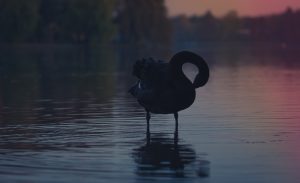
Where does stormwater go?
At UMBC stormwater ultimately flows into the Patapsco River and into the Chesapeake Bay. This is why it is so important to ensure that only rain goes down a storm drain!
How does UMBC manage stormwater?
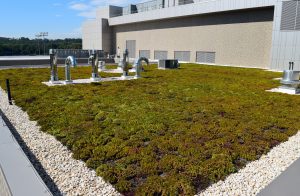 At UMBC, stormwater is well managed to control flooding, reduce erosion, and improve water quality. UMBC has installed over 90 best management practices (BMPs) across campus. BMPs are structural, vegetative, or managerial practices used to treat, prevent, or reduce water pollution. Some of the BMPs are highly visible, like the several green roofs on campus; whereas, other BMPs are designed invisibly blend in like permeable pavement.
At UMBC, stormwater is well managed to control flooding, reduce erosion, and improve water quality. UMBC has installed over 90 best management practices (BMPs) across campus. BMPs are structural, vegetative, or managerial practices used to treat, prevent, or reduce water pollution. Some of the BMPs are highly visible, like the several green roofs on campus; whereas, other BMPs are designed invisibly blend in like permeable pavement.